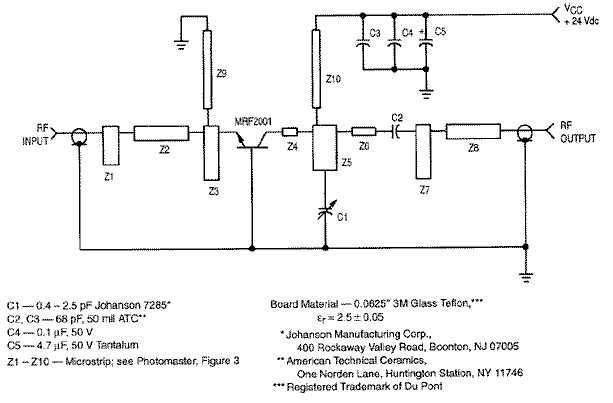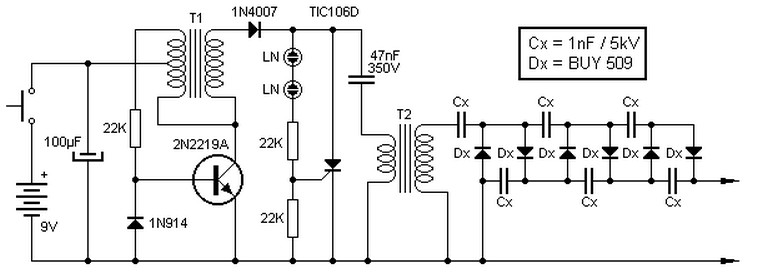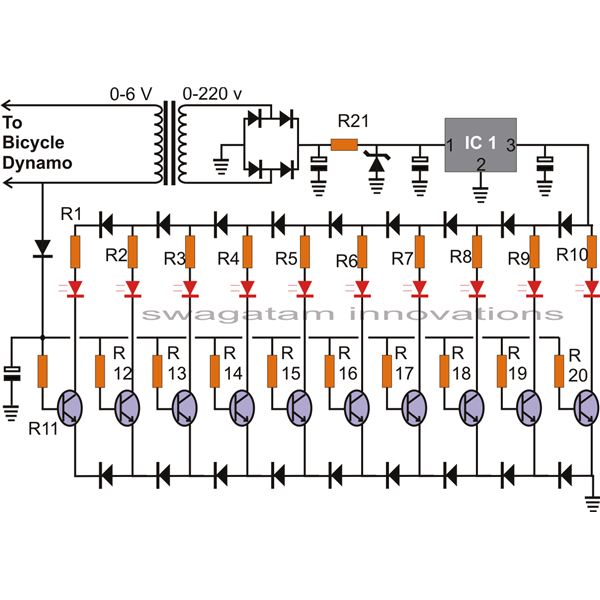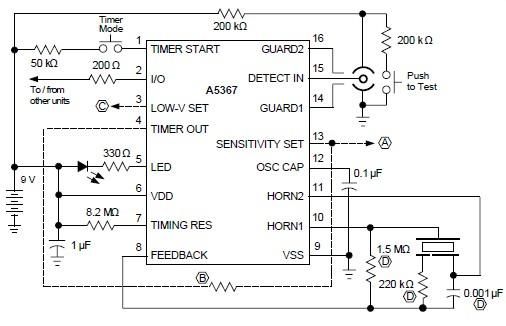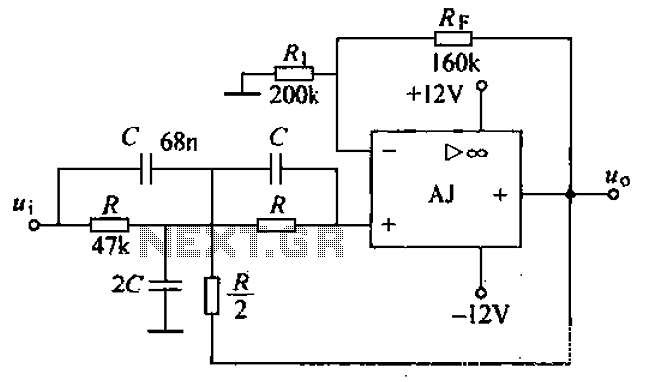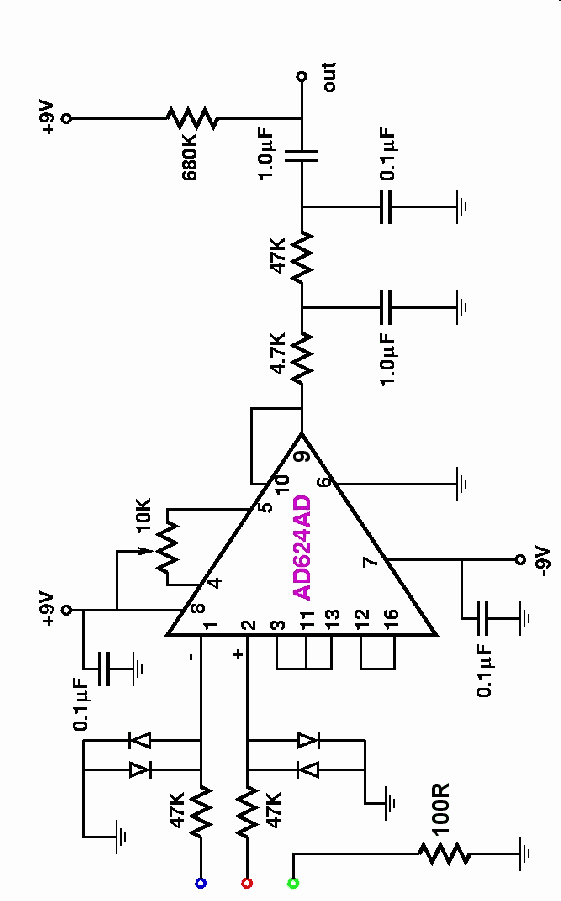
audio visual ringer circuit diagram

Often, there is a need for an additional telephone ringer in an adjacent room to indicate an incoming call. For instance, if the telephone is located in the drawing room, an extra ringer may be required in the bedroom. This can be achieved by connecting the provided circuit in parallel with the existing telephone lines using twin flexible wires. This circuit does not necessitate an external power source for operation. The section that includes resistor R1 and diodes D5 and LED1 offers a visual indication of the ringing. The remaining part of the circuit consists of an audio ringer based on IC1 (BA8204 or ML8204). This integrated circuit, designed specifically for telecommunications applications as a bell sound generator, requires very few external components and is available in an 8-pin mini DIP package. Resistor R3 is utilized for adjusting bell sensitivity. The bell frequency is determined by resistor R5 and capacitor C4, while the repeat frequency is regulated by resistor R4 and capacitor C3. Some experimentation with the values of the resistors and capacitors may be necessary to achieve the desired tone. The circuit operates simply: the bell signal, approximately 75V AC, passes through capacitor C1 and resistor R2, appearing across the diode bridge formed by diodes D1 to D4. The rectified DC output is smoothed by capacitor C2. The dual-tone ring signal is output from pin 8 of IC1, with volume adjusted by volume control VR1. This signal is then sent to the piezo-ceramic sound generator.
The circuit design for the additional telephone ringer is straightforward and effective, providing both auditory and visual notifications for incoming calls. The integration of the BA8204 or ML8204 IC simplifies the design, as it minimizes the number of required external components, thereby enhancing reliability and reducing assembly complexity. The use of a diode bridge for rectification ensures that the AC ringing signal is converted to a usable DC voltage, which is essential for powering the audio output stage.
Resistor R1 serves as a current limiter for the LED indicator, ensuring that it operates within safe limits while providing a clear visual alert. The combination of capacitors C1 and C2 in conjunction with the diode bridge allows for effective smoothing of the rectified signal, which is crucial for stable operation of the audio ringer.
The audio output, which is modulated by the adjustable resistors R3, R4, and R5, allows for customization of both the sensitivity and frequency characteristics of the ringer. This feature is particularly beneficial in environments where varying levels of ambient noise may affect the audibility of the ringer. The piezo-ceramic sound generator is chosen for its high efficiency and compact size, making it suitable for integration into various settings.
In summary, this additional telephone ringer circuit offers a practical solution for enhancing notification of incoming calls in separate rooms, with the flexibility for users to tailor the sound output to their preferences. Careful selection of component values and configuration allows for a versatile design that meets the needs of diverse applications.Many a times one needs an ex- tra telephone ringer in an ad- joining room to know if there is an incoming call. For example, if the telephone is installed in the drawing room you may need an extra ringer in the bedroom.
All that needs to be done is to connect the given circuit in parallel with the existing telephone lines using twin flexible wires . This circuit does not require any external power source for its operation. The section comprising resistor R1 and diodes D5 and LED1 provides a visual indication of the ring. Remaining part of the circuit is the audio ringer based on IC1 (BA8204 or ML8204). This integrated circuit, specially designed for telec- om application as bell sound generator, requires very few external parts. It is readily available in 8-pin mini DIP pack. Resistor R3 is used for bell sensitivity adjustment. The bell frequency is controlled by resistor R5 and capacitor C4, and the repeat frequency is controlled by resistor R4 and capacitor C3.
A little experimentation with the various values of the resistors and capacitors may be carried out to obtain desired pleasing tone. Working of the circuit is quite simple. The bell signal, approximately 75V AC, passes through capacitor C1 and resistor R2 and appears across the diode bridge comprising diodes D1 to D4.
The rectified DC output is smoothed by capacitor C2. The dual-tone ring signal is output from pin 8 of IC1 and its volume is adjusted by volume control VR1. Thereafter, it is impressed on the piezo-ceramic sound generator Disclaimer: All the information present on this site are for personal use only.
No commercial use is permitted without the prior permission from authors of this website. All content on this site is provided as is and without any guarantee on any kind, implied or otherwise. We cannot be held responsible for any errors, omissions, or damages arising out of use of information available on this web site.
The content in this site may contain COPYRIGHTED information and should not be reproduced in any way without prior permission from the authors. 🔗 External reference
The circuit design for the additional telephone ringer is straightforward and effective, providing both auditory and visual notifications for incoming calls. The integration of the BA8204 or ML8204 IC simplifies the design, as it minimizes the number of required external components, thereby enhancing reliability and reducing assembly complexity. The use of a diode bridge for rectification ensures that the AC ringing signal is converted to a usable DC voltage, which is essential for powering the audio output stage.
Resistor R1 serves as a current limiter for the LED indicator, ensuring that it operates within safe limits while providing a clear visual alert. The combination of capacitors C1 and C2 in conjunction with the diode bridge allows for effective smoothing of the rectified signal, which is crucial for stable operation of the audio ringer.
The audio output, which is modulated by the adjustable resistors R3, R4, and R5, allows for customization of both the sensitivity and frequency characteristics of the ringer. This feature is particularly beneficial in environments where varying levels of ambient noise may affect the audibility of the ringer. The piezo-ceramic sound generator is chosen for its high efficiency and compact size, making it suitable for integration into various settings.
In summary, this additional telephone ringer circuit offers a practical solution for enhancing notification of incoming calls in separate rooms, with the flexibility for users to tailor the sound output to their preferences. Careful selection of component values and configuration allows for a versatile design that meets the needs of diverse applications.Many a times one needs an ex- tra telephone ringer in an ad- joining room to know if there is an incoming call. For example, if the telephone is installed in the drawing room you may need an extra ringer in the bedroom.
All that needs to be done is to connect the given circuit in parallel with the existing telephone lines using twin flexible wires . This circuit does not require any external power source for its operation. The section comprising resistor R1 and diodes D5 and LED1 provides a visual indication of the ring. Remaining part of the circuit is the audio ringer based on IC1 (BA8204 or ML8204). This integrated circuit, specially designed for telec- om application as bell sound generator, requires very few external parts. It is readily available in 8-pin mini DIP pack. Resistor R3 is used for bell sensitivity adjustment. The bell frequency is controlled by resistor R5 and capacitor C4, and the repeat frequency is controlled by resistor R4 and capacitor C3.
A little experimentation with the various values of the resistors and capacitors may be carried out to obtain desired pleasing tone. Working of the circuit is quite simple. The bell signal, approximately 75V AC, passes through capacitor C1 and resistor R2 and appears across the diode bridge comprising diodes D1 to D4.
The rectified DC output is smoothed by capacitor C2. The dual-tone ring signal is output from pin 8 of IC1 and its volume is adjusted by volume control VR1. Thereafter, it is impressed on the piezo-ceramic sound generator Disclaimer: All the information present on this site are for personal use only.
No commercial use is permitted without the prior permission from authors of this website. All content on this site is provided as is and without any guarantee on any kind, implied or otherwise. We cannot be held responsible for any errors, omissions, or damages arising out of use of information available on this web site.
The content in this site may contain COPYRIGHTED information and should not be reproduced in any way without prior permission from the authors. 🔗 External reference
Warning: include(partials/cookie-banner.php): Failed to open stream: Permission denied in /var/www/html/nextgr/view-circuit.php on line 713
Warning: include(): Failed opening 'partials/cookie-banner.php' for inclusion (include_path='.:/usr/share/php') in /var/www/html/nextgr/view-circuit.php on line 713
